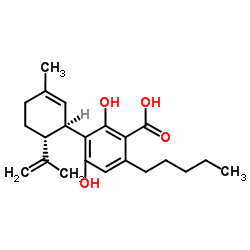CBDA

CBDA structure
|
Common Name | CBDA | ||
|---|---|---|---|---|
| CAS Number | 1244-58-2 | Molecular Weight | 358.471 | |
| Density | 1.1±0.1 g/cm3 | Boiling Point | 530.8±50.0 °C at 760 mmHg | |
| Molecular Formula | C22H30O4 | Melting Point | N/A | |
| MSDS | Chinese USA | Flash Point | 288.9±26.6 °C | |
| Symbol |


GHS02, GHS07 |
Signal Word | Danger | |
|
Development and Validation of a Reliable and Robust Method for the Analysis of Cannabinoids and Terpenes in Cannabis.
J. AOAC Int. 98 , 1503-22, (2015) The requirements for an acceptable cannabis assay have changed dramatically over the years resulting in a large number of laboratories using a diverse array of analytical methodologies that have not been properly validated. Due to the lack of sufficiently val... |
|
|
Medicinal Cannabis: In Vitro Validation of Vaporizers for the Smoke-Free Inhalation of Cannabis.
PLoS ONE 11 , e0147286, (2016) Inhalation by vaporization is a promising application mode for cannabis in medicine. An in vitro validation of 5 commercial vaporizers was performed with THC-type and CBD-type cannabis. Gas chromatography/mass spectrometry was used to determine recoveries of ... |
|
|
Metabolomic differentiation of Cannabis sativa cultivars using 1H NMR spectroscopy and principal component analysis.
J. Nat. Prod. 67(6) , 953-7, (2004) The metabolomic analysis of 12 Cannabis sativa cultivars was carried out by 1H NMR spectroscopy and multivariate analysis techniques. Principal component analysis (PCA) of the 1H NMR spectra showed a clear discrimination between those samples by principal com... |
|
|
Neuromotor tolerability and behavioural characterisation of cannabidiolic acid, a phytocannabinoid with therapeutic potential for anticipatory nausea.
Psychopharmacology 233 , 243-54, (2016) Anticipatory nausea (AN) is a poorly controlled side effect experienced by chemotherapy patients. Currently, pharmacotherapy is restricted to benzodiazepine anxiolytics, which have limited efficacy, have significant sedative effects and induce dependency. The... |
|
|
Cannabidiolic acid prevents vomiting in Suncus murinus and nausea-induced behaviour in rats by enhancing 5-HT1A receptor activation.
Br. J. Pharmacol. 168(6) , 1456-70, (2013) To evaluate the ability of cannabidiolic acid (CBDA) to reduce nausea and vomiting and enhance 5-HT(1A) receptor activation in animal models.We investigated the effect of CBDA on (i) lithium chloride (LiCl)-induced conditioned gaping to a flavour (nausea-indu... |
|
|
Growth characteristics of Cannabis sativa L. cultivated in a phytotron and in the field.
Kokuritsu Iyakuhin Shokuhin Eisei Kenkyusho. Hokoku. (122) , 16-20, (2004) Growth characteristics of Cannabis saliva L. are indispensable factors to verify the statements by the criminals of illegal cannabis cultivation. To investigate growth characteristics of C. sativa, two varieties, cannabidiolic acid (CBDA)-rich (CBDA-type) whi... |
|
|
Cannabidiolic acid as a selective cyclooxygenase-2 inhibitory component in cannabis.
Drug Metab. Dispos. 36(9) , 1917-21, (2008) In the present study it was revealed that cannabidiolic acid (CBDA) selectively inhibited cyclooxygenase (COX)-2 activity with an IC(50) value (50% inhibition concentration) around 2 microM, having 9-fold higher selectivity than COX-1 inhibition. In contrast,... |
|
|
Cannabidiolic acid, a major cannabinoid in fiber-type cannabis, is an inhibitor of MDA-MB-231 breast cancer cell migration.
Toxicol. Lett. 214(3) , 314-9, (2012) Cannabidiol (CBD), a major non-psychotropic constituent of fiber-type cannabis plant, has been reported to possess diverse biological activities, including anti-proliferative effect on cancer cells. Although CBD is obtained from non-enzymatic decarboxylation ... |
|
|
Marijuana extracts possess the effects like the endocrine disrupting chemicals.
Toxicology 206(3) , 471-8, (2005) The progesterone 17alpha-hydroxylase activity, which is one of the steroidogenic enzymes in rat testis microsomes, was significantly inhibited by crude marijuana extracts from Delta(9)-tetrahydrocannabinolic acid (THCA)- and cannabidiolic acid (CBDA)-strains.... |
|
|
Purification and characterization of cannabidiolic-acid synthase from Cannabis sativa L.. Biochemical analysis of a novel enzyme that catalyzes the oxidocyclization of cannabigerolic acid to cannabidiolic acid.
J. Biol. Chem. 271(29) , 17411-6, (1996) We identified a unique enzyme that catalyzes the oxidocyclization of cannabigerolic acid to cannabidiolic acid (CBDA) in Cannabis sativa L. (CBDA strain). The enzyme, named CBDA synthase, was purified to apparent homogeneity by a four-step procedure: ammonium... |